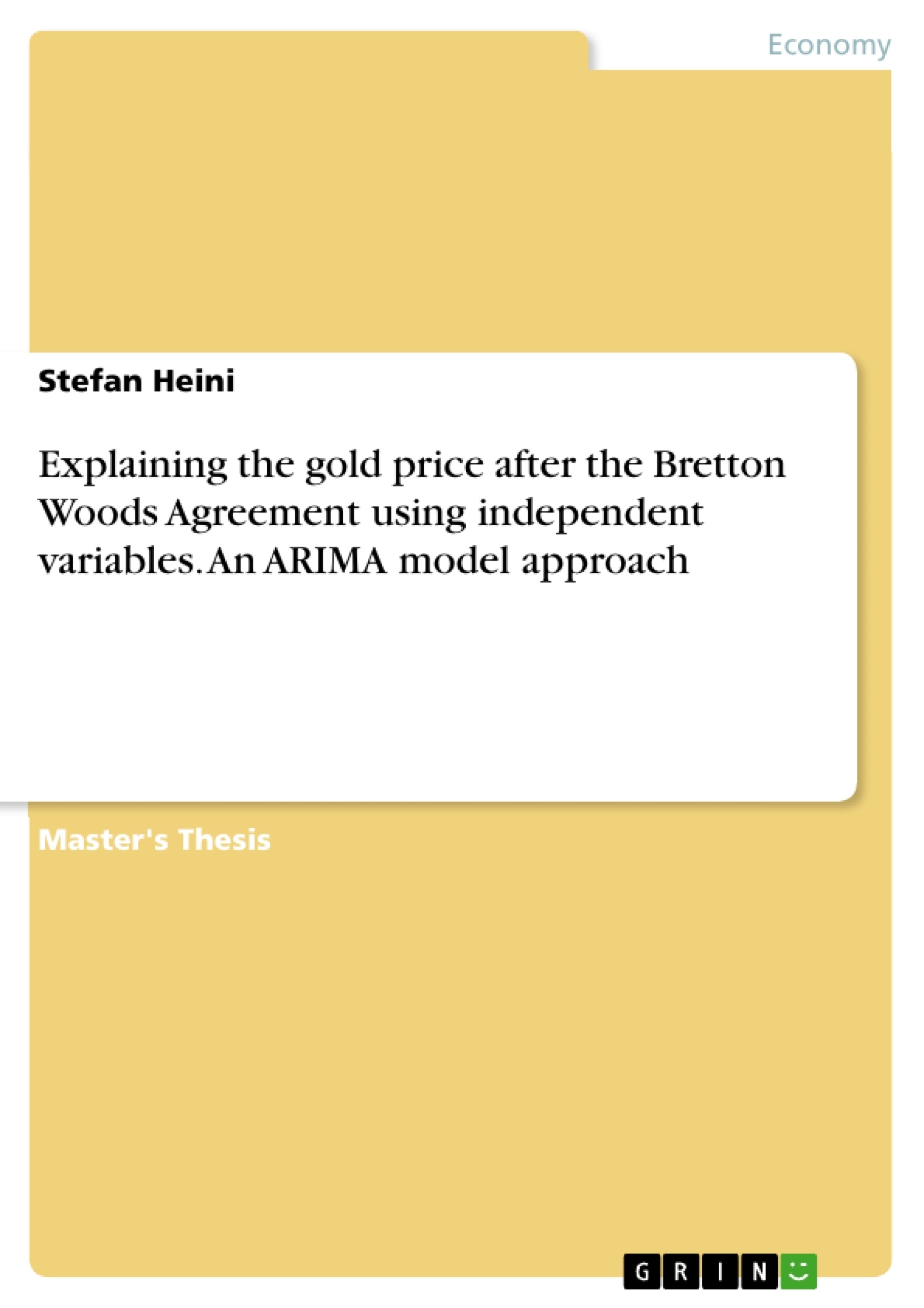To date, nobody has formulated a comprehensive theorem to determine gold valuation or precious metal prices. Until fairly recently, Eugene Fama’s Efficient Market Hypothesis was the predominant paradigm explaining asset markets but today it is widely acknowledged that markets can be irrational and investors are prone to act irrationally. When trying to explain gold market anomalies, behavioural science approaches can be useful. Phenomena such as herding (‘group think’), ‘safe value bias’ and investors’ ‘excessive extrapolation’ can help explain positive price performance over a certain time.
In this dissertation, the author investigates the applicability of a multivariate ARIMA (auto-regressive, integrated, moving average) model to help explain gold price movements from 1973 to 2011. This model uses the gold price and independent variables such as inflation, real interest rates, silver prices, the US dollar money supply (M2), oil prices, the MSCI World index and the S&P 500 as these are linked to gold and/or highly correlated with the gold price. The evaluation criteria were defined as R-squared, mean absolute percentage error (MAPE) and BIC. The model was calculated over so-called ‘normal times’ and times of crises (one political, one financial). The researcher used SPSS’ Expert Modeler to find the best-fitting ARIMA model and to identify the independent variables significantly contributing to the fit of the model. Remarkably, a multivariate ARIMA model using independent variables explained almost twice as much of the variability of the gold price as a univariate ARIMA model using only the gold price. Also, throughout the complete period and during normal times the model explained a much higher percentage of the variability of the gold price than during crises and comparably more of the independent variables contributed significantly to the fit of the model (5 vs. 2). This can be explained by investors’ tendencies to buy gold to preserve their assets (“safe value”), to follow the crowd (“herding”) and to extrapolate past price chart developments.
The results show that in an attempt to discern the cause of gold price movements, a multivariate ARIMA model outperforms a univariate ARIMA model significantly. The results of the study furthermore indicate researchers evaluating different methods to fit a time series should consider a multivariate ARIMA model, especially if the independent variables are highly correlated with the dependent variable.
Table of Contents
- Chapter 1 - Introduction
- 1.1 Background
- 1.2 Gold is different
- 1.3 The gold price since the end of Bretton Woods
- 1.4 Research questions
- Chapter 2 - Literature Review and Theory
- 2.1 Theoretical framework: Explaining the movements of the gold price
- 2.2 Empirical findings: Independent variables correlating with the gold price
- 2.3 Conclusion
- Chapter 3 - Data and Methods
- 3.1 The ARIMA model
- 3.2 Assumptions of an ARIMA model
- 3.3 Data collection and sources
- 3.4 Defining an ARIMA model to fit the gold price
- 3.5 Evaluation of the ARIMA model
- 3.6 Conclusion
- Chapter 4 - Analysis and Results
- 4.1 Data description
- 4.2 The best fitting ARIMA model
- 4.3 ARIMA model fit during normal times and crises
- 4.4 Explaining divergences of the model fit during normal times and crises
- 4.5 Conclusion
- Chapter 5 - Discussion and Conclusions
- 5.1 Summary
- 5.2 Implications
- 5.3 Limitations
- 5.4 Direction for Future Research
- 5.5 Reflections
Objectives and Key Themes
This dissertation aims to investigate the factors driving the gold price after the Bretton Woods Agreement by applying an ARIMA model. The study utilizes historical data to identify and quantify the impact of various independent variables on the gold price.
- The gold price dynamics after the Bretton Woods Agreement
- Identifying independent variables that influence the gold price
- Applying an ARIMA model to forecast the gold price
- Evaluating the model's performance during normal times and economic crises
- Exploring the implications of the findings for investors and policymakers
Chapter Summaries
Chapter 1 provides an introduction to the research topic, highlighting the significance of gold in the global financial system and the unique characteristics that differentiate it from other assets. It examines the gold price behavior since the end of the Bretton Woods system and outlines the research questions that guide the study.
Chapter 2 presents a comprehensive literature review, exploring existing theoretical frameworks for explaining gold price movements. It examines previous empirical studies that have identified independent variables correlating with the gold price and discusses their findings.
Chapter 3 delves into the methodology employed in the research, explaining the ARIMA model and its assumptions. It details the data collection process, sources used, and the steps involved in defining and evaluating the ARIMA model to fit the gold price.
Chapter 4 presents the results of the analysis, including a description of the data, the best-fitting ARIMA model, and its performance during different economic conditions. The chapter analyzes the model's fit during both normal times and economic crises, exploring the factors that contribute to divergences in its performance.
Keywords
The core concepts and themes explored in this dissertation include: gold price, Bretton Woods Agreement, ARIMA model, independent variables, financial markets, economic crises, inflation, interest rates, exchange rates, global economic uncertainty, forecasting, and investment strategies.
- Quote paper
- Stefan Heini (Author), 2014, Explaining the gold price after the Bretton Woods Agreement using independent variables. An ARIMA model approach, Munich, GRIN Verlag, https://www.grin.com/document/304522



